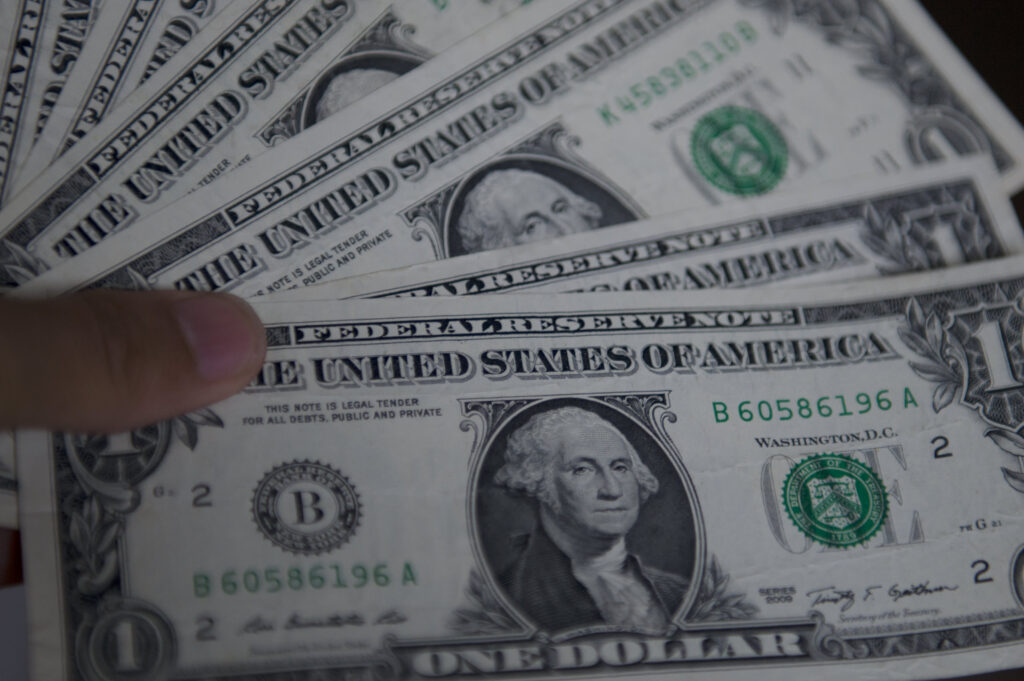(Reuters) – The dollar gained on Wednesday after U.S. retail sales fell less than expected in October, bouncing off its biggest drop in a year the previous day when cooler U.S. inflation data added to expectations that the Federal Reserve is done raising rates.
Retail sales slipped 0.1% last month and data for September was revised higher to show sales increasing 0.9% instead of the previously reported 0.7% rise, the U.S. Commerce Department’s Census Bureau said.
Economists polled by Reuters had forecast retail sales would fall 0.3%.
The better than expected reading lifted the dollar, even though a weak reading on producer prices, along with Tuesday’s consumer price index report, signaled a cooling economy that still suggests the Fed’s fight against inflation is on track.
“Today’s (retail sales) number doesn’t really move the needle one way or the other, other than sort of convince you that things are definitely slowing down in the U.S. still,” said Brad Bechtel, global head of FX at Jefferies in New York.
The fourth quarter in the past two years has not been good for the dollar, which peaked in the third quarter of both 2021 and 2022 and sold off through to January each year, Bechtel said.
“I’m not necessarily saying that history is going exactly to repeat itself, but I don’t necessarily want to be buying or getting long the dollar just yet,” he said. “We need to see more of this play out.”
The dollar index, a measure of the U.S. currency versus six others, rose 0.33%, off its two-month low of 103.98 on Tuesday. The euro was down 0.36% at $1.084, after touching its highest since August the day before.
Investors have all but wiped out the chance of another rate hike from the Fed in December, while bets of a rate cut in May next year increased to more than 65%, according to the CME Group’s FedWatch Tool.
In Britain, inflation eased to its slowest pace in two years in October, which prompted a reassessment of the outlook for Bank of England policy and dented sterling.
“For me what this does concern is we’re done, when it comes to rate hikes, and it’s a question of when do rate cuts come and that’s what markets are staring to price, particularly if you look at the bond market,” CMC Markets (LON:CMCX) chief market strategist Michael Hewson said.
The pound eased back from Tuesday’s two-month highs after data showed British inflation ran at its slowest pace in two years in October, at 4.6%. This was below forecasts for a reading of 4.8% and below September’s 6.7% reading.
Sterling was last down almost 0.6% at $1.2429. On Tuesday, the pound rose by 1.8% against the dollar, marking its biggest one-day gain in a year.
The dollar was stronger against the yen, up 0.45% at 151.65 after the retails sales date. Earlier in Japan, data showed the economy contracted in July-September, complicating the Japanese central bank’s efforts to ease out of its ultra-easy monetary policy. On Monday, the yen hit a one-year low close to 152.
The dollar was knocked back from the 152 level on Monday, after a routine options expiry unleashed some profit-taking that took the yen to around 151.20.
LSEG data shows Wednesday’s New York expiry has around $3.9 billion in open interest between 150.50 and 152, with $2.6 billion at 152 alone, which might create more volatility.
The offshore Chinese yuan, meanwhile, received some support The offshore yuan, meanwhile, briefly ticked up to a three-month high of $7.2385 against the dollar after domestic industrial output and retail sales growth beat expectations.
Evidence of ongoing weakness in China’s property sector, where data showed sales fell faster in October and investment in real estate slumped, took some of the shine off the rally.



